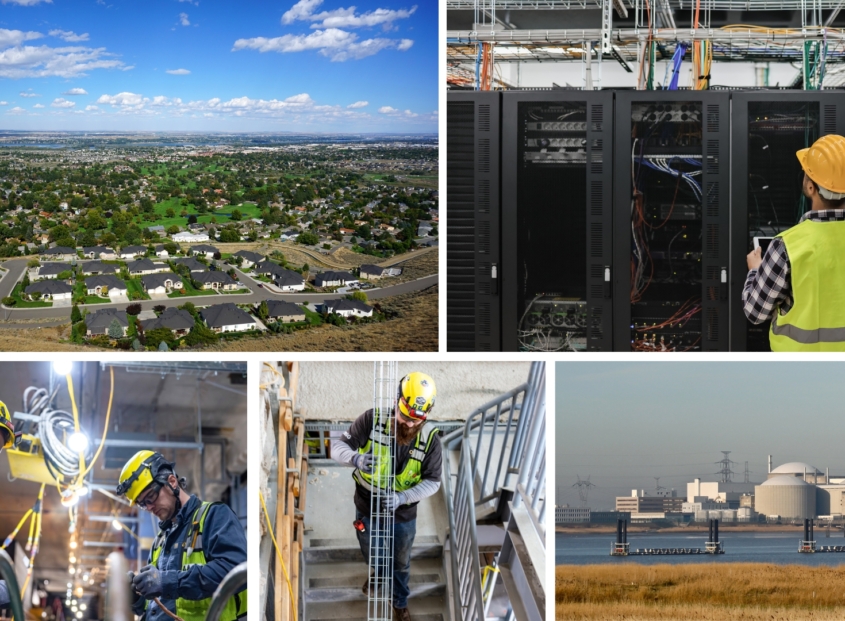The Rise of Small Modular Reactors (SMRs) in the Energy Sector
It’s no secret that energy demands will increase in the coming years. As a result, tech companies are looking for ways to handle demand while supporting sustainability goals.
In certain areas of The Pacific Northwest, small modular reactors (SMRs) offer innovative solutions to the energy sector. Keep reading to find out more.
What are Small Modular Reactors?
Small modular reactors (SMRs) are today’s cutting-edge evolution of traditional nuclear power systems. They have a smaller footprint, produce less nuclear waste than larger reactors, and are completely modular.
Unlike nuclear-based energy systems in the past, SMRs don’t require as much construction or land allocation. Plus, SMRs use far less carbon than larger systems. Smaller reactors typically have a power output of 300 megawatts of electricity per plant, compared to 1,000 megawatts of traditional models. This demonstrates that smaller reactors can still produce sufficient energy while being more compact and manageable.
SMRs Support Carbon-Neutral Energy Sources
Small modular reactors produce energy in the same way as traditional reactors. Heavy atoms are split through nuclear fission into smaller ones, which release energy as heat. Harnessing this power can generate electricity without reliance on carbon-based sources.
What makes SMRs much more environmentally friendly is their scalability, which enables them to expand with energy demands and serve diverse populations—from commercial to residential. SMRs can also integrate into other renewable power sources, like wind and solar, further reducing greenhouse gas emissions. Plus, SMRs don’t require frequent refueling. Some are designed to last 30 years without a refuel. Others can go 3 to 7 years without needing extra fuel. Unlike conventional plants, which require refueling every 1 to 2 years, SMRs can operate for longer periods without requiring frequent refueling.
How SMRs Are Powering Pacific Northwest Data Centers
Data centers across the PNW are growing, and companies are looking for innovative, carbon-neutral solutions. SMRs have the potential to meet the ever-expanding energy needs of data centers while serving sustainability goals and reducing utility costs.
Nuclear Power in The Pacific Northwest Today
Exciting changes are coming to the energy sector in the PNW through SMRs. Their low-carbon power and reliable energy meet the region’s clean energy goals. Combining local energy innovators with the technology industry also positions the PNW as a pioneer in advanced nuclear solutions.
Check out what’s on the horizon!
Data Center Energy Innovation in the Tri-Cities
In late 2024, Amazon announced its goal to invest in nuclear technology to power its data services. As Amazon seeks to grow its data centers to meet demand, it has also announced a goal to become zero-net carbon by 2040. To achieve these objectives, Amazon plans to fund four SMRs by 2030 in Washington State to address the energy needs of the data center boom.
Safety Initiatives in Nuclear Energy
Some states across the U.S., including Oregon, currently have a block on new nuclear infrastructure. However, SMRs have come a long way from the massive reactors of the past. According to data from Energy Northwest, SMRs will produce a low rate of 50 megawatts and won’t exceed 300. The compact size of SMRs also creates a more stable environment because they are less likely to overheat and do not require human assistance to instigate a shutdown. These safety features contribute to making SMRs a reliable and secure energy solution.
The Role of the Energy Sector
With Amazon’s large-scale SMR project breaking ground in the coming years, electrical professionals will be integral to setting up and maintaining systems. Nuclear electricians and contractors will be in high demand, with roles ranging from integrating renewable energy to testing equipment and making system modifications. Their expertise will be essential in shaping the future of the energy sector.
The NECA/IBEW Partnership: Innovating The Pacific Northwest’s Energy Future
For more than a century NECA and IBEW Local 48 members have been at the heart of powering Oregon and Washington. Through this enduring partnership, we’ve built the region’s electrical infrastructure and paved the way toward a sustainable energy future.
By joining our community of skilled professionals, you become part of a legacy of excellence, innovation, and continuous growth. Driven by craftsmanship, leadership, and a commitment to progress, we’re shaping a brighter, more efficient future for The Pacific Northwest. Get details about membership, benefits, and more.




